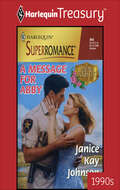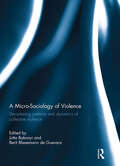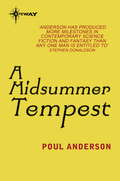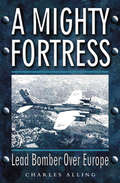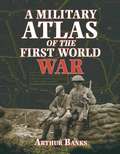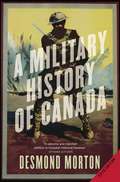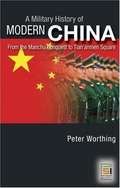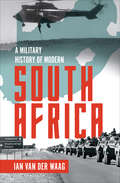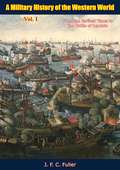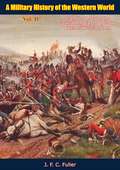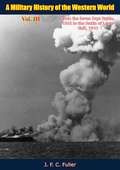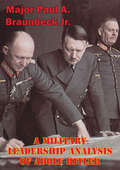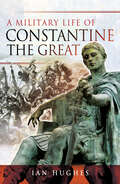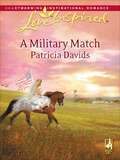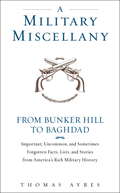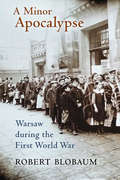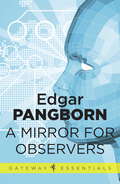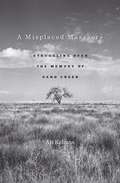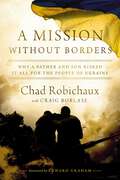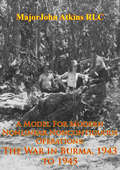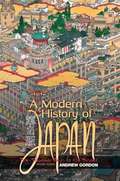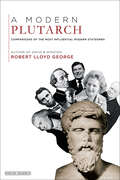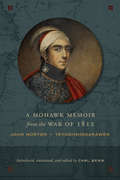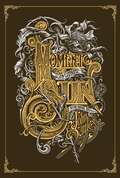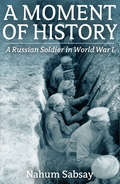- Table View
- List View
A Message for Abby (Patton's Daughters #3)
by Janice Kay JohnsonPATTON'S DAUGHTERSThe people of Elk Springs, Oregon, thought Ed Patton was a good man, a good cop, a good father. But his daughters know the truth....Abby's the third Patton sister. The baby. The one everyone said was privileged, spoiled. But a childhood with a harsh unapproachable father and only vague memories of a mother wasn't easy. Even if she did work hard to make it look that way.Now Abby's determined to live up to her image and have fun. Until she meets Detective Ben Shea, a man who's plenty serious-about his job, his life and suddenly her.Maybe, just maybe, it would pay to get serious.
A Micro-Sociology of Violence: Deciphering patterns and dynamics of collective violence
by Berit Bliesemann de Guevara Jutta BakonyiThis book aims at a deeper understanding of social processes, dynamics and institutions shaping collective violence. It argues that violence is a social practice that adheres to social logics and, in its collective form, appears as recurrent patterns. In search of characteristics, mechanisms and logics of violence, contributions deliver ethnographic descriptions of different forms of collective violence and contextualize these phenomena within broader spatial and temporal structures. The studies show that collective violence, at least if it is sustained over a certain period of time, aims at organization and therefore develops constitutive and integrative mechanisms. Practices of social mobilization of people and economic resources, their integration in functional structures, and the justification or legitimization of these structures sooner or later lead to the establishment of new forms of (violent) orders, be it at the margins of or beyond the state. Cases discussed include riots in Gujarat, India, mass violence in Somalia, social orders of violence and non-violence in Colombia, humanitarian camps in Uganda, trophy-taking in North America, and violent livestock raiding in Kenya. This book was originally published as a special issue of Civil Wars.
A Midsummer Tempest: A Holger Danske Book
by Poul AndersonSomewhere, spinning through another universe is an Earth where a twist of fate, a revolution and a few early inventions have made a world quite unlike our own.It is a world where Cavaliers and Puritans battle with the aid of observation balloons and steam trains; where Oberon and Titania join forces with King Arthur to resist the Industrial Revolution; and where the future meshes with the past in the shape of Valeria, time traveller from New York.
A Mighty Fortress: Lead Bomber Over Europe
by Chuck Alling&“In a fascinating way, Chuck Alling recalls his days as a pilot flying B-17s over Germany. He is truly a member of &‘The Greatest Generation&’&” (Former Pres. George H.W. Bush). A Mighty Fortress is the personal account of the captain and crew of a lead bomber in the enormous formation raids made by the Eighth Air Force during the last few months of the Second World War. It is an extraordinary tale of heroism and bravery on the part of the entire crew of just one B-17 amongst hundreds—but the one B-17 that meant most to them. Having flown twenty-seven missions before the war ended, Alling tells what it was like to be there, in the skies over enemy territory, constantly on the lookout for German fighters; of the enormity of some of the raids they were part of and the consequences for those on the ground; of the planes around them that fell out of the sky under enemy attack; of the horror and the determination to succeed. From a recipient of the Distinguished Flying Cross and the Air Medal with four Oak Leaf Clusters, this book gives a unique insight into the lives of one crew of one plane as the war neared its end.
A Military Atlas of the First World War
by Arthur Banks“With the ingenious use of maps, diagrams and statistics, this indispensable work explains the strategies of the combatants and the diplomatic history.” —The BeaconThis is a unique study of the conflict of 1914–18 on land, sea and in the air, through maps, diagrams and illustrations. Within the scope of some 250 maps, Arthur Banks has presented both broad general surveys of political and military strategy, and the most closely researched details of major individual campaigns and engagements. These are supplemented by comprehensive analysis of military strengths and command structures and illustrations.“One of the best books of maps I’ve seen about any war. With 250 separate maps, you get something on just about every aspect of the war, from the familiar Western Front to the Zeppelin raids over Britain, through to the campaigns in the Middle East and beyond.” —History of War“I am delighted that, after being out-of-print from time to time, this reprint has arrived, to answer the prayers of teachers, pupils, researchers and others who need a quick and accurate reference guide.” —Stand To! (journal of The Western Front Association)
A Military History of Canada
by Desmond MortonUpdated to 2007, including Canada's war on terrorism. Is Canada really "a peaceable kingdom" with "an unmilitary people"? Nonsense, says Desmond Morton. This is a country that has been shaped, divided, and transformed by war -- there is no greater influence in Canadian history, recent or remote.From the shrewd tactics of Canada's First Nations to our troubled involvement in Somalia, from the Plains of Abraham to the deserts of Afghanistan, Morton examines our centuries-old relationship to war and its consequences. This updated edition also includes a new chapter on Canada's place in the war on terrorism.A Military History of Canada is an engaging and informative chronicle of Canada at war, from one of the country's finest historians.From the Trade Paperback edition.
A Military History of Modern China: From the Manchu Conquest to Tian'anmen Square
by Peter M. Worthing"Organized chronologically, this book is divided into three sections designed to reveal the manner in which war and the military have influenced the course of Chinese history. The first section, Imperial China, underscores the importance of war in China by dealing with the Manchu conquest and military rule over China, the developing technology gap between China and the West, the devastating defeats at the hands of Western powers in the 19th century, and early attempts at military reform and modernization. " "The second section, Republican China, traces important military reforms that gave rise to a revolutionary movement, the overthrow of the monarchy, and attempts to establish a democratic republic. The military played a dominant role in the search for a viable, modern political state during this period, which saw intense fighting between independent "warlords," contending political parties that used military force against their rivals, and a Japanese invasion. " "The third section, People's Republic of China, reveals the critical role of the military and warfare in the period after the Chinese Communist Party came to power. It explores the Chinese Communist role in the Korean War, border clashes with the Soviet Union, India, and Vietnam, changes in military doctrine, organization, and technology, the People's Liberation Army's violent suppression of the 1989 student demonstrations, and the military situation in the Taiwan Strait. The book also includes a section on modern military reform, acquisition of military technology, and relations with Taiwan. "--BOOK JACKET.
A Military History of Modern South Africa
by Ian van der WaagThe story of a century of conflict and change—from the Second Boer War to the anti-apartheid movement and the many battles in between. Twentieth-century South Africa saw continuous, often rapid, and fundamental socioeconomic and political change. The century started with a brief but total war. Less than ten years later, Britain brought the conquered Boer republics and the Cape and Natal colonies together into the Union of South Africa. The Union Defence Force, later the SADF, was deployed during most of the major wars of the century, as well as a number of internal and regional struggles: the two world wars, Korea, uprising and rebellion on the part of Afrikaner and black nationalists, and industrial unrest. The century ended as it started, with another war. This was a flash point of the Cold War, which embraced more than just the subcontinent and lasted a long thirty years. The outcome included the final withdrawal of foreign troops from southern Africa, the withdrawal of South African forces from Angola and Namibia, and the transfer of political power away from a white elite to a broad-based democracy. This book is the first study of the South African armed forces as an institution and of the complex roles that these forces played in the wars, rebellions, uprisings, and protests of the period. It deals in the first instance with the evolution of South African defense policy, the development of the armed forces, and the people who served in and commanded them. It also places the narrative within the broader national past, to produce a fascinating study of a century in which South Africa was uniquely embroiled in three total wars.
A Military History of the Western World, Vol. I: From the Earliest Times to the Battle of Lepanto (A Military History of the Western World #1)
by J. F. C. FullerA magnificent work of history, ten years in the writing, which covers the great captains and commanders, the decisive battles on land and sea, the influence of weapons, and the military factors which have influenced the rise and fall of civilizations in the Western world.Major-General J. F. C. Fuller, a pioneer of mechanized warfare in Great Britain, was one of the twentieth century’s most renowned military strategists and historians. In this magisterial work, he spans military history from the Greeks to the end of World War II, describing tactics, battle lines, the day-to-day struggles while always relating affairs on the field to the larger questions of social, political, and economic change in Western civilization.A masterpiece of scholarship and biting prose, this first volume of three includes the rise of imperialism, the major battles, and the political and social changes from Greece, Rome, the Carolingian Empire, Byzantium, the siege and fall of Constantinople in 1453, to the rise of the Spanish and Ottoman Empires and the Battle of Lepanto in 1571.“General Fuller’s ‘Military History,’ seen as a whole, is a magnificent survey of the evolution of western military organization, tactics and strategy from the earliest times to the present: and perhaps its outstanding feature is the fact that this evolution is always seen within the context of political and social history, the author being careful to demonstrate the reciprocal relationship which exists between military establishments on the one hand and civilian societies which support them on the other.”—New York Herald Tribune
A Military History of the Western World, Vol. II: From the Defeat of the Spanish Armada, 1588, to the Battle of Waterloo, 1815 (A Military History of the Western World #2)
by J. F. C. FullerThe greatest military historian of our time continues his magnificent chronicle of the wars, battles, captains and commanders, weapons, and ideologies which have shaped the Western world.Major-General J. F. C. Fuller, a pioneer of mechanized warfare in Great Britain, was one of the twentieth century’s most renowned military strategists and historians. In this magisterial work he spans military history from the Greeks to the end of World War II, describing tactics, battle lines, the day-to-day struggles while always relating affairs on the field to the larger questions of social, political, and economic change in Western civilization.A masterpiece of scholarship and biting prose, this second volume of three describes the 16th-century rivalry between England and Spain, the Thirty Years War, struggle between France and England, American Revolutionary War, and the rise and fall of Napoleon.“General Fuller’s ‘Military History,’ seen as a whole, is a magnificent survey of the evolution of western military organization, tactics and strategy from the earliest times to the present: and perhaps its outstanding feature is the fact that this evolution is always seen within the context of political and social history, the author being careful to demonstrate the reciprocal relationship which exists between military establishments on the one hand and civilian societies which support them on the other.”—New York Herald Tribune
A Military History of the Western World, Vol. III: From the Seven Days Battle, 1862 to the Battle of Leyte Gulf, 1944 (A Military History of the Western World #3)
by J. F. C. FullerThis final volume encompasses the period of the American Civil War to the end of the Second World War with extraordinary and objective analysis and judgment in chronicling its wars and battles and gigantic political conflicts.Major-General J. F. C. Fuller, a pioneer of mechanized warfare in Great Britain, was one of the twentieth century’s most renowned military strategists and historians. In this magisterial work he spans military history from the Greeks to the end of World War II, describing tactics, battle lines, the day-to-day struggles while always relating affairs on the field to the larger questions of social, political, and economic change in Western civilization.A masterpiece of scholarship and biting prose, this third and final volume outlines the age of industrialism and the rise of American imperialism, the Civil War, expansionist policies of Japan and Russia, and World Wars I and II, offering fresh insights into the relationship between military history and social change.“Any new book by Maj. Gen. J. F. C. Fuller is an event in the field of military history, and with the publication of this third and final volume of his survey of warfare he brings to a close the most comprehensive work of a long career.”—The New York Times“The grand chronicle is completed with this third volume of what must certainly become one of the most important military studies ever accomplished.”—San Francisco Chronicle“Readers of Major-General Fuller’s two earlier volumes on the military history of the Western world will find in this third and final portion all the ingredients which make his work one of the best in recent military studies.”—Christian Science Monitor
A Military Leadership Analysis Of Adolf Hitler
by Major Paul A. Braunbeck Jr."Before the war, and still more during the conquest of the West, Hitler came to appear a gigantic figure, combining the strategy of a Napoleon with the cunning of a Machiavelli and the fanatical fervour of a Mohomet. After his first check in Russia, his figure began to shrink, and towards the end he was regarded as a blundering amateur in the military field, whose crazy orders and crass ignorance had been the Allies' greatest asset. All the disasters of the German Army were attributed to Hitler; all its successes were credited to the German General Staff." - B. H. Liddell HartLiddell Hart goes on to say that while this description of Adolf Hitler may not be entirely true, there is certainly some truth to it. While conducting the research for this project, it became increasing apparent that in the late 1930s Hitler was indeed a successful military leader. The impetus behind this success was partly due to Hitler's political decision making process which, in effect, laid the foundation for World War II. However, as his success continued to mount, he became more and more involved in the intricacies of battlefield tactics and strategy. This is where Hitler's and Germany's eventual downfall for the conquest of Europe began. Upon examining Hitler's strengths, weaknesses, and decision making processes as a military leader one can begin to fully appreciate how the infamous "stop" order at Dunkirk and his "no retreat" policy at Stalingrad are often referred to as Hitler's greatest blunders of World War II.
A Military Life of Constantine the Great
by Ian HughesA new analysis of the strengths, organization, weapons, and tactics of the Roman army Constantine inherited and his military reforms.Much of Constantine I’s claim to lasting fame rests upon his sponsorship of Christianity, and many works have been published assessing whether his apparent conversion was a real religious experience or a cynical political maneuver. However, his path to sole rule of the Roman Empire depended more upon the ruthless application of military might than upon his espousal of Christianity. He fought numerous campaigns, many against Roman rivals for Imperial power, most famously defeating Maxentius at the Battle of the Milvian Bridge. In this new study, Ian Hughes assesses whether Constantine would have deserved the title “the Great” for his military achievements alone, or whether the epithet depends upon the gratitude of Christian historians.All of Constantine’s campaigns are narrated and his strategic and tactical decisions analyzed. The organization, strengths, and weaknesses of the Roman army he inherited are described and the effect of both his and his predecessors’ reforms discussed. The result is a fresh analysis of this pivotal figure in European history from a military perspective.
A Military Match
by Patricia DavidsFrom US TODAY bestselling author, Patricia DavidsEveryone—especially his estranged grandfather—thinks Private Avery Barnes is just a wealthy playboy. Yet the military taught him to value what can't be bought—honor and love. And if he wins the top prize at the cavalry competition, he'll show his grandfather he's made of more than his birthright. He needs lovely veterinarian's assistant Jennifer Grant to help him train.Except that Jennifer is wary about Avery's commitment—to the competition and to her.Will Avery be able to shed his reputation and win both the competition and, the ultimate prize, Jennifer's heart?From Love Inspired: Uplifting stories of faith, forgiveness and hope.Discover the North Country Amish miniseries by Patricia Davids:Book 1: Shelter from the StormBook 2: The Amish Teacher's DilemmaBook 3: A Haven for ChristmasBook 4: Someone to TrustBook 5: An Amish Mother for His TwinsBook 6: Mistaken for His Amish BrideBook 7: Christmas on His Doorstep
A Military Miscellany: From Bunker Hill to Baghdad -- Important, Uncommon, and Sometimes Forgotten Facts, Lists, and Stories from America's Military History
by Thomas AyresFor armchair generals, history buffs, and military enthusiasts everywhere,A Military Miscellany is an essential and entertaining collection of fascinating and little-known facts, anecdotes, lists, and stories from America's rich military legacy. Forgotten heroes, amazing blunders, surprising trivia, and strange-but-true stories overlooked by historians, it's all here in a book that will enlighten and amaze even the most avid student of American military history. Did you know that American soldiers have been sent to invade foreign nations or their territories more than two hundred times since Thomas Jefferson dispatched troops to North Africa in 1803 to punish Muslim pirates? Or that during the Vietnam War a can opener was called a John Wayne? Or that a downed World War II airman once trekked across Germany, through occupied France, and across the mountains into Spain to avoid capture-only to be treated as a spy because Allied military intelligence said it couldn't be done? Open this book anywhere and you'll find yourself instantly captivated. From the "peace president" who was our most frequent practitioner of gunboat diplomacy to the Revolutionary War hero whose refusal to cut his hair set off a four-year rebellion that went all the way to the White House, there's plenty of fascinating lore here--from the monumental to the trivial--in an indispensable encyclopedic work that takes up where ordinary history books leave off.
A Minor Apocalypse: Warsaw during the First World War
by Robert BlobaumIn A Minor Apocalypse, Robert Blobaum explores the social and cultural history of Warsaw's "forgotten war" of 1914–1918. Beginning with the bank panic that accompanied the outbreak of the Great War, Blobaum guides his readers through spy scares, bombardments, mass migratory movements, and the Russian evacuation of 1915. Industrial collapse marked only the opening phase of Warsaw’s wartime economic crisis, which grew steadily worse during the German occupation. Requisitioning and strict control of supplies entering the city resulted in scarcity amid growing corruption, rapidly declining living standards, and major public health emergencies. Blobaum shows how conflicts over distribution of and access to resources led to social divisions, a sharp deterioration in Polish-Jewish relations, and general distrust in public institutions. Women’s public visibility, demands for political representation, and perceived threats to the patriarchal order during the war years sustained one arena of cultural debate. New modes of popular entertainment, including cinema, cabaret, and variety shows, created another, particularly as they challenged elite notions of propriety. Blobaum presents these themes in comparative context, not only with other major European cities during the Great War but also with Warsaw under Nazi German occupation a generation later.
A Mirror for Observers (Gateway Essentials #104)
by Edgar PangbornThe Martians, long exiled from their home planet, have for millennia been observers of the world of men. Forbidden by their laws to interfere with human destiny, they wait for mankind to mature.From the turmoil of mid twentieth-century America, word comes to the Observers that one of their renegades is hoping to encourage humanity in its headlong rush to self-destruction through corruption of a single rare intellect. The struggle between Observer and Abdicator for the continuance of the human species is one the classic conflicts in the annuals of science fiction.
A Misplaced Massacre
by Ari KelmanIn the early morning of November 29, 1864, with the fate of the Union still uncertain, part of the First Colorado and nearly all of the Third Colorado volunteer regiments, commanded by Colonel John Chivington, surprised hundreds of Cheyenne and Arapaho people camped on the banks of Sand Creek in southeastern Colorado Territory. More than 150 Native Americans were slaughtered, the vast majority of them women, children, and the elderly, making it one of the most infamous cases of state-sponsored violence in U. S. history. A Misplaced Massacre examines the ways in which generations of Americans have struggled to come to terms with the meaning of both the attack and its aftermath, most publicly at the 2007 opening of the Sand Creek Massacre National Historic Site. This site opened after a long and remarkably contentious planning process. Native Americans, Colorado ranchers, scholars, Park Service employees, and politicians alternately argued and allied with one another around the question of whether the nation’s crimes, as well as its achievements, should be memorialized. Ari Kelman unearths the stories of those who lived through the atrocity, as well as those who grappled with its troubling legacy, to reveal how the intertwined histories of the conquest and colonization of the American West and the U. S. Civil War left enduring national scars. Combining painstaking research with storytelling worthy of a novel, A Misplaced Massacre probes the intersection of history and memory, laying bare the ways differing groups of Americans come to know a shared past.
A Mission Without Borders: Why a Father and Son Risked it All for the People of Ukraine
by Chad RobichauxAuthor, speaker, and former Force Recon Marine Chad Robichaux offers an honest, no-holds-barred account of what has really been happening in Ukraine and shares powerful stories that are soaked in resiliency and determination, faith and sacrifice in the face of overwhelming opposition.When Russian forces invaded Ukraine on February 24, 2022, former Force Recon Marine Chad Robichaux knew that innocent people were about to be exposed to untold brutality. He also knew that God was inviting him to get involved. With little idea of the trials that would follow, Chad's response was simple and clear: "yes." As he gathered a team of elite special operations veterans, he invited his twenty-five-year-old son, Hunter--also a Marine combat veteran--to partner with him in Ukraine. Over the course of seven trips, Chad saw a change in Hunter as his confidence grew and he exceled among the team. Chad's own faith also grew as he learned to relinquish control and trust God with his son and what he witnessed in the brutality of war.A Mission Without Borders is a powerful account of the lessons we can learn whenever we say yes to God. Chad's experience will help readersunderstand what the conflict in Ukraine was like for everyday citizens beyond the political fog;discover how a bond can grow between a father and son as they face hardship together; andrealize that God doesn't just call us to go to the aid of the people we know and love, sometimes he calls us to help strangers--because it's the right thing to do. A Mission Without Borders will take readers deep into the war in Ukraine. From Russia's use of ballistic and chemical weapons on civilians, to the inspirational story of the role that the Ukrainian church has played in the war, Chad's story of courage and hope needs to be heard. It is rich in human and spiritual truth and will connect deeply with readers of all walks.
A Model For Modern Nonlinear Noncontiguous Operations: The War In Burma, 1943 To 1945
by Major John Atkins RLCThe War in Burma is all too frequently forgotten as a source of relevant military experience. Admittedly it did not have the strategic importance of other theatres such as the Pacific or North West Europe, but it did witness some of the hardest and most bitter fighting of the War. Because of the nature of the terrain, limited allied resources and the type of dispersed operations conducted by the enemy, Allied forces were forced to adapt a new method of warfighting to counter these difficulties. The aircraft and the radio revolutionised the way that the campaign was to be conducted. It was discovered for the first time that formations could be dispersed across the battlespace and could fight independently of a ground line of communication. The first formation to prove that this approach was possible was the 77th Brigade, later to earn the title of Chindits and commanded by Brigadier Orde Wingate. Employing Wingate's theories of Long Range Penetration for the first time, the Chindits travelled hundreds of miles behind the enemy's forward positions and attacked his rear areas and lines of communication. Throughout the operation, they received all their supply requirements from transport aircraft and were never in physical contact with friendly forces. The Chindits conducted a truly joint, mobile, nonlinear and noncontiguous operation. Within a year, conventional brigades, divisions and corps of the British Fourteenth Army and the American/Chinese forces in northern Burma were conducting similar operations, this time supported by many more aircraft for both logistic sustainment and fires. Field Marshall William Slim called it a new way of fighting and suggested that four elements contributed to the new concept: joint operations, the use of mission command, the reduction of the logistic footprint of the force to increase tempo, and the conduct of operations by dispersed forces which are tactically independent but focused on operational-level objectives.
A Modern History of Japan: From Tokugawa Times to the Present (2nd edition)
by Andrew GordonGordon (history and Japanese studies, Harvard U.) begins his history in about 1800, looking at how particularly the industrial revolution had changed the balance of global economic and military power, and the pressures that caused the Tokugawa military lords to fall from power. Annotation (c)2003 Book News, Inc., Portland, OR (booknews.com)
A Modern Plutarch: Comparisons of the Most Influential Modern Statesmen
by Robert Lloyd GeorgeInspired by the Ancient Greek biographer, this volume offers comparative assessments of important leaders from American and British history. One of the most significant and enduring texts of Ancient Greece is Plutarch&’s Lives of the Noble Greeks and Romans. In it, the &“Father of Biography&” paired off the most notable and influential figures of the classical world, placing their lives and legacies next to each other, allowing the comparisons and juxtapositions to reveal new truths about these famous men. He compared Demosthenes with Cicero, Alexander the Great with Julius Caesar; the result was an intellectual masterpiece still referred to by historians today. In A Modern Plutarch, Robert Lloyd George applies this model of biography to the most influential statesmen and stateswomen of American and British history. Lloyd George compares figures such as Edmund Burke, a prophet of modern conservatism, and Thomas Paine, a champion for the common man. He juxtaposes Winston Churchill and Abraham Lincoln, two of the greatest wartime leaders of the past 200 years, and Margaret Thatcher and Ronald Reagan, the first divisive, the latter popular. In doing so, he draws parallels between their lives and philosophies, while revealing the traits that made them unique. An essential primer on leadership and an inspiring account of exceptional lives, A Modern Plutarch offers remarkable insight into some of the greatest minds of the modern era.
A Mohawk Memoir from the War of 1812: John Norton - Teyoninhokarawen
by John Norton TeyoninkarawenA Mohawk Memoir from the War of 1812 presents the story of John Norton, or Teyoninhokarawen, an important war chief and political figure among the Grand River Haudenosaunee (or Iroquois) in Upper Canada. Norton saw more action during the conflict than almost anyone else, being present at the fall of Detroit, the capture of Fort Niagara, the battles of Queenston Heights, Fort George, Stoney Creek, Chippawa, and Lundy’s Lane, the blockades of Fort George and Fort Erie, as well as a large number of skirmishes and front-line patrols. His memoir describes the fighting, the stresses suffered by indigenous peoples, and the complex relationships between the Haudenosaunee and both their British allies and other First Nations communities. Norton’s words, written in 1815 and 1816, provide nearly one-third of the book’s content, with the remainder consisting of Carl Benn’s introductions and annotations, which enable readers to understand Norton’s fascinating autobiography within its historical contexts. With the assistance of modern scholarship, A Mohawk Memoir presents an exceptional opportunity to explore the War of 1812 and native-newcomer issues through Teyoninhokarawen’s Mohawk perspectives from a period that produced few indigenous autobiographies, of which Norton’s is the most extensive, engaging, and reliable.
A Moment in the Sun
by John SaylesIt's 1897. Gold has been discovered in the Yukon. New York is under the sway of Hearst and Pulitzer. And in a few months, an American battleship will explode in a Cuban harbor, plunging the U.S. into war. Spanning five years and half a dozen countries, this is the unforgettable story of that extraordinary moment: the turn of the twentieth century, as seen by one of the greatest storytellers of our time.Shot through with a lyrical intensity and stunning detail that recall Doctorow and Deadwood both, A Moment in the Sun takes the whole era in its sights-from the white-racist coup in Wilmington, North Carolina to the bloody dawn of U.S. interventionism in the Philippines. Beginning with Hod Brackenridge searching for his fortune in the North, and hurtling forward on the voices of a breathtaking range of men and women-Royal Scott, an African American infantryman whose life outside the military has been destroyed; Diosdado Concepcíon, a Filipino insurgent fighting against his country's new colonizers; and more than a dozen others, Mark Twain and President McKinley's assassin among them-this is a story as big as its subject: history rediscovered through the lives of the people who made it happen.
A Moment of History A Russian Soldier in World War I
by Nahum SabsayA Moment of History, first published in 1960, is Nahum Sabsay's dramatic account of his years as a front-line Russian soldier fighting the Germans and Austrians. Especially memorable is his description of the an informal truce where the Russian and Austrian troops, separated by a No-man's land, sang and danced together, followed the next day by intense artillery barrages on each side. The book also depicts the fall of Czarist Russia and the fight against the Communist Red Army. Choosing to flee this chaos, author Sabsay would travel eastward across Siberia, arriving in the U.S. In 1918, he would go on to study mining engineering at Harvard and moved to California where he worked as a tool and die maker while perfecting his English and writing. Sabsay died in 1965.
